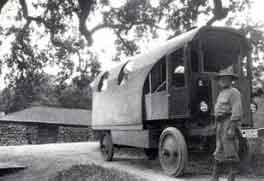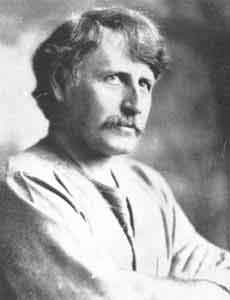Published in the January 6 – 19, 2016 issue of Morgan Hill Life
By Mike Monroe
Many residents of Santa Clara County are unfamiliar with the story of Charles Kellogg. I find that observation unfortunate, and it has motivated me to share his adventures and exploits whenever there is an audience willing (or perhaps unwilling) to listen.
There are an abundance of stories and themes to explore about this rare individual who called Morgan Hill his home for the last 35 years of his life. His passing in Sept. 1949 was noted in a number of newspapers, including the San Jose Evening News, as a “lover of nature who won world-wide fame yet was a genial man and always humble. He preached kindliness, tolerance and love of animals and our landscapes.”
One of his lasting legacies is on display at the Humboldt Redwoods State Park Visitor Center. It is a hollowed out redwood log mounted on the chassis of a Nash Quad truck which he drove through cities on both the East and West coasts to raise awareness about the devastating logging practices in our redwood forests. He called his vehicle “The Travel Log.” Although his move to Morgan Hill in 1913 might have indicated that he and his wife were ready to enjoy a semi-retirement of sorts, Kellogg had way too much creative and physical energy to mellow with middle age. In 1917, patriotic fervor was sweeping across the United States as the country prepared to enter World War I. In his late 40s, Kellogg had built his hillside cabin and had developed Kellogg Springs and his Ever Ever Ranch, and he now was ready to climb back on the national stage. And did he ever make an appearance.

Photo courtesy Humboldt Redwoods Interpretive Association
Charles Kellogg with his Nash Quad truck he called “The Travel Log” and used as the center of attention to encourage the sale of war bonds and to raise awareness about the devastating logging practices in California’s redwood forests.
Charles decided to help the war effort by using his prominence as a vaudeville and Victor Records entertainer to promote the sale of Liberty Bonds. The Travel Log would be the center of attention wherever he traveled. Not only did he encourage the sale of war bonds, he passionately spoke out about the conservation of California redwoods.
Old growth redwoods were being rapidly mowed down by the timber industry during the late 1800s. The clearing of the trees continued unabated into the new century, especially to facilitate the rebuilding of San Francisco after the 1906 earthquake.
The Santa Cruz Mountains had mostly been clear cut except for the efforts of the Sempervirens Club to preserve the Big Basin area. Improved handling and milling machinery plus new road construction was pushing “the harvest” further northward along the coastline to go after the huge redwoods above Mendocino County.
A number of people grew concerned about the wasting of our redwood resources and the felling of these majestic trees just to make grape stakes, fencing or railroad ties. Charles Kellogg decided to stand up for the redwoods.
But how could he make a dramatic statement to capture public attention? People needed to see the redwoods up close and personal to fully experience age and size these trees.
A sudden inspiration came to him when he witnessed the Nash Quad truck hauling very heavy loads through rough terrain during a military training exercise. Within a week he was in contact with the Nash Company and made arrangements for a new chassis to be delivered to Morgan Hill in the spring of 1917.
Knowing that his plan to install a redwood log on the Nash Quad would take a sustained effort, the truck chassis was driven up the Santa Catherina roadway (an extension of today’s Maple Avenue) and outfitted with a canvas cover and packed full of camping supplies. The project would take three months to identify a colossal downed redwood, hollow it out by hand, and mount the shell on the Nash chassis for the return trip to Morgan Hill. The log was located at Bull Creek Flat, now a part of Humboldt Redwoods State Park, home of some the largest redwoods in the world.
Something else happened during that summer at Bull Creek Flat. Three prominent scientists at the request of Stephen Mather, the new chief of the National Park Service, visited the area where Kellogg was working on his Travel Log.
There are no documents to support my conclusion, but my opinion is that John C. Merriam, Henry Fairfield Osborn and Madison Grant met with Kellogg along Bull Creek and together they determined to “Save the Redwoods.” The league was formally incorporated in 1918 and Kellogg was a lifetime member. Back home in Morgan Hill, he designed the interior of the Travel Log to include a bed, storage cabinets, a sink, and it even had electricity. The back door was made of solid redwood burl and weighed when finished probably 500 pounds.
For two years, the Travel Log toured the United States and crowds surrounded it wherever Kellogg decided to visit. When the grand excursion was complete, Kellogg removed the shell and placed it under a covered awning alongside his Morgan Hill home. Later in his life, he asked a San Martin family to keep it on their property where it was used for storage until the 1990s.
Then, word of the Travel Log reached a state park’s supervising ranger who knew the Kellogg story and quickly it was removed from our local history and taken to its new home in Humboldt County.
If you are interested in the Kellogg story, start with an on-line visit to the Charles Kellogg Travel Log where there are many articles and photographs plus a NPR piece with an audio presentation.
Wishing everyone a healthy and happy 2016 in our Valley of Heart’s Delight.
Mike Monroe is a business owner and naturalist. He is a docent for Santa Clara County Parks.







